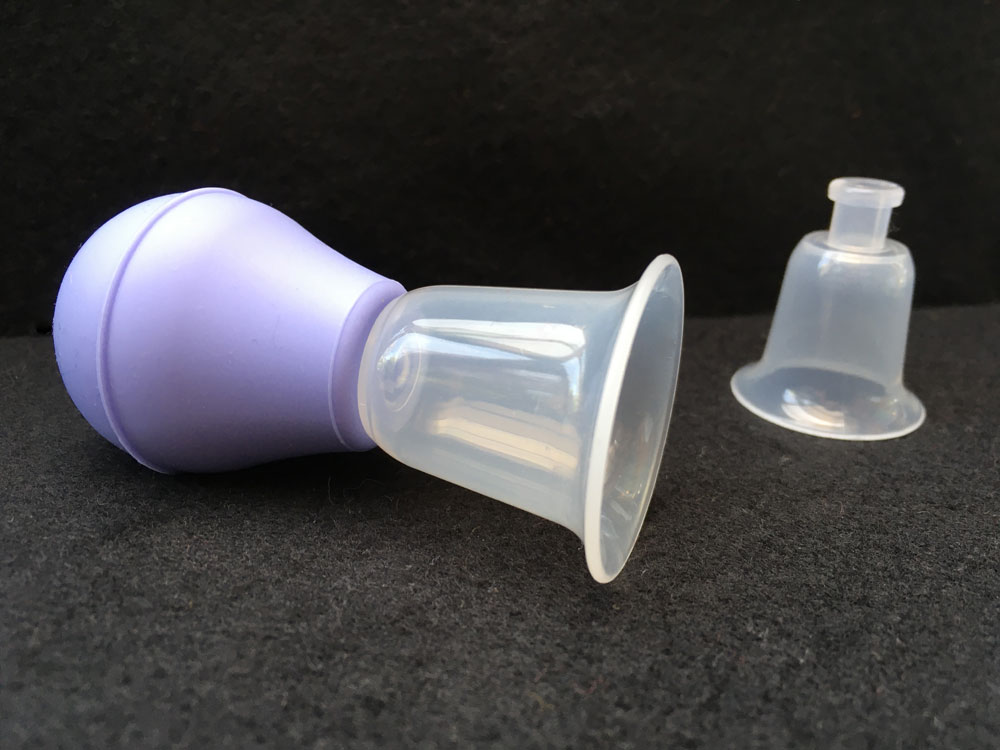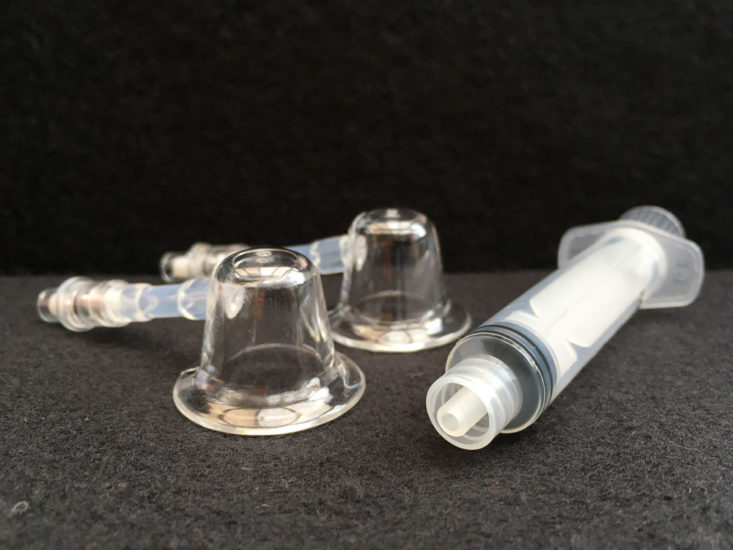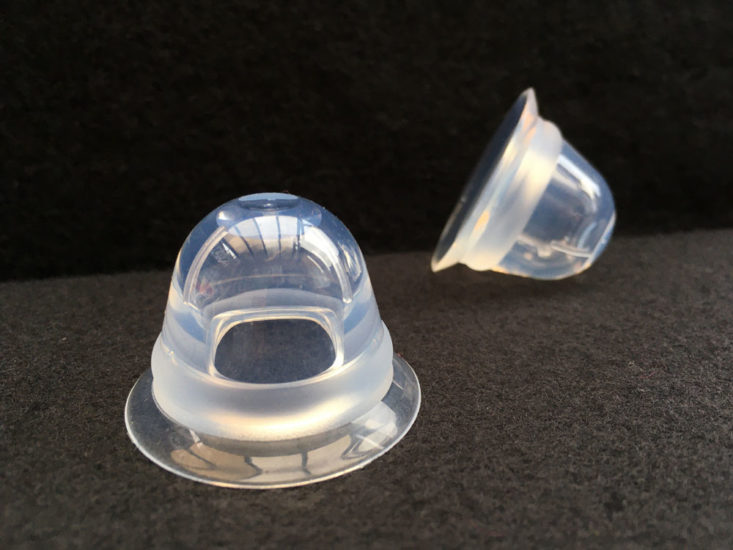Nipples (and breasts) come in all shapes and sizes and not always in matching pairs. Not all nipples protrude like half a cherry on a cup cake. Some nipples may be quite shallow or flat, perhaps level with the areola (the darker skin around the nipple), others can be dimpled or folded, very long or wide. Some nipples are inverted or retracted—where the nipple points into the breast instead of sticking out. This article looks at whether flat or inverted nipples can affect breastfeeding and how to deal with any challenges.
Can you breastfeed with inverted nipples or flat nipples?
Many mothers can breastfeed with flat or inverted nipples because breastfeeding relies on a baby having a big mouthful of breast to stimulate the milk glands behind the nipple rather than simply being a matter of hanging on to a nipple. However, while some babies find breastfeeding with inverted nipples or flat nipples quite straightforward, others find it more difficult. Potential issues include:
Latching
The way a baby attaches to the breast is often referred to as latching. A protruding nipple can be easier for a baby to find and grasp and guides a baby’s latch. Conversely, a flatter, short shanked nipple may be quite difficult for a baby to find and grasp, especially at first while a baby is learning to breastfeed. The after effects of birth medications or birth trauma can also be causes of difficulty latching and/or coping with variations in anatomy.
Knowing when to suck
The stimulus of a nipple (or finger or bottle teat) pulled deeply into a baby’s mouth triggers the sucking reflex when it touches the baby’s hard palate. Faced with a soft, flat nipple, a baby may feel confused and disorientated; bobbing back and forth as she tries to grasp the nipple or falling asleep in frustration. Once a baby has been exposed to a stronger stimulus such as a bottle teat, they may expect and prefer it, making attempts to help them latch on even more difficult.
Forming a teat
If the nipple is flat and the breast tissue is very firm instead of soft and stretchy, a baby may find it difficult to shape the breast into a teat shape to suckle and stay latched. If a baby is premature, has low muscle tone (floppy) or has high muscle tone, a small mouth, poor latch or has a restrictive tongue-tie, it may compound his difficulties.
Sore nipples
If a baby doesn’t have a big mouthful of breast as well as the nipple in their mouth (a shallow latch), a mother’s nipples can rub against a baby’s hard palate and quickly become sore. Careful attention to the way a baby is held (positioning) can help with this and certain positions may be more helpful than others when a mother has flatter nipples. Reclining while breastfeeding with baby on their tummy may help some mothers, or for others, a more upright position such as cross cradle may give more control for a deeper latch. A couple of weeks of continuous sucking (or pumping with a good pump) can gradually draw out flat or inverted nipples permanently and improve comfort levels for some mothers.1
Ongoing nipple pain
Occasionally pain might continue even when breastfeeding is going well because the nipple has undergone major changes due to stretching or because the bands of tissue that are inverting the nipple stay tight and may crack or blister (Mohrbacher, 2020 p741) .
Risk of low milk supply or low weight gain
If it is difficult for a baby to get a deep latch due to the shape of his mother’s nipples, there is a higher risk of having a low milk supply. This is because the breasts may not be emptied thoroughly and efficient breast drainage is the stimulus for a good milk supply. If this is the case, a baby could be at risk of low weight gain.2
The buried nipple
Sometimes when a baby latches to an inverted nipple, it can compress the buried nipple rather than squeezing the breast tissue behind the nipple as usual. This can prevent the baby getting any milk and will also be painful for the mother. In this situation a breast pump may be helpful as this will tend to draw the nipple out rather than squeezing the buried nipple (Mohrbacher. 2020 p 740).
How flat is a flat nipple?
There is a wide variation of normal, but some authors describe an average nipple diameter as 16mm and height as 7mm.3 However, whether there will be any problems for your baby if your nipples are much flatter (or much larger) than average will depend on the size of your baby’s mouth, how stretchy the breast tissue is and whether you have good help to get breastfeeding started.
What is an inverted nipple?
When a nipple is inverted it points into the breast or lies flat on the breast instead of protruding outwards. This may be due to short milk ducts, tight bands of connective tissue pulling the centre of the nipple into the breast or an absence of connective tissue supporting the nipple.4 Pressing on the areola either side of and about an inch behind your nipple (sometimes called “the pinch test”) can reveal whether a nipple is inverted. An inverted nipple will pull into the breast (retract) but everted or protruding nipples stay out like a cherry on a cake. If you can coax the nipple out, that’s a good sign that your baby will be able to do the same if he is latched well.
There can be different degrees of inversion or retraction from mild to severe, descriptions in the breastfeeding literature include;
- Retracted.5 Some nipples appear “graspable” but on stimulation e.g. with the pinch test, pull into the breast which can make latching difficult. The degree of retraction might be minimal or moderate to severe affecting whether an infant can pull the nipple forward during breastfeeds or not (Wambach and Spencer, 2021 p64).
- Pseudo-inverted (Core Curriculum, 2012. p271) or simple inversion (Wambach and Spencer, 2021 p64). Nipples may look inverted but become erect on stimulation which should not present a problem to the breastfed baby.
- Dimpled nipples. A dimpled or folded nipple is a partially inverted nipple where only part of the nipple protrudes. This nipple may extend during a breastfeed but after the feed it folds back over and may become damp and sore inside. Patting the nipple dry after a feed or holding it open until it is dry can help avoid soreness or skin breakdown.6
- Inverted, truly inverted or complete inversion. The inverted nipple that is retracted both before and after stimulation is not common but where present it makes it more difficult for a baby to latch (Core Curriculum, 2012; Wambach and Spencer, 2021 p 64).
Inverted nipples may resolve
Nipples continue to develop during pregnancy under the influence of hormones so that many inverted nipples turn out (evert) by the end of pregnancy and may even protrude a little further with each subsequent pregnancy (Wambach and Spencer, 2021 p 64). If a baby can manage to latch and feed regularly this can loosen the adhesions that keep some nipples inverted. A good breast pump may also do this.
Tips for breastfeeding with flat or inverted nipples
Some babies may not have any difficulties breastfeeding with inverted nipples or flat nipples. But some will. Paying careful attention to latch and positioning can help your baby breastfeed successfully. Useful articles providing general information to help all babies latch include Breastfeeding Tips for Newborns, Latching Tips, Breastfeeding Positions for Newborns and Why Skin to Skin? Further tips include:
#1 A natural birth (and a breast crawl)
Where possible, a baby will be better able to master latching after birth if he isn’t too sleepy and disorientated from drugs such as strong pain killers that have crossed the placenta. Also, in certain positions, a baby’s natural breastfeeding instincts and reflexes are primed which helps them to breastfeed. Letting a baby crawl to the breast when first born (and at other times during the first few weeks) can also help with this (Mohrbacher 2020). For videos see Why Skin-to-Skin?

#2 Getting a good latch
A breastfeeding specialist such as an IBCLC lactation consultant can help to get breastfeeding off to a great start and can help you one-to-one with latching techniques and helpful positions whether reclining or using more upright holds. Ideas to help a baby latch to a flat or inverted nipple include:
Help baby to use their reflexes
Holding a baby in skin-to-skin contact to breastfeed, removing scratch mittens and trying reclining positions can enable a baby to use their feeding reflexes to help them latch.
Shaping or flattening the breast
In more upright breastfeeding positions, variations of breast shaping, sometimes called an assisted latch, nipple tilt, flipple or breast sandwich may help a baby get a deeper latch. Ensure your fingers are far enough back from your nipple so your baby can get a big mouthful of breast. See Latching Tips for a description and video clips. You may need to continue to support the breast through the feed if the latch is fragile.
A nipple shield
A nipple shield can help some babies to latch to a very flat or inverted nipple. See Nipple Shields Good or Bad? for further information about shields. If used, it’s important that the nipple shield fits well. Listen for your baby’s swallows and keep an eye on his weight gain and dirty nappies to ensure he is getting enough milk. Pumping regularly will protect your milk supply until you’re sure feeding is going well. Wetting the shield can help keep them in place either with breast milk or some mothers use a little lanolin around the edges of the shield. Avoid using a shield during the first few days before your milk comes in as thick and sticky colostrum doesn’t flow well through a shield; you could hand express instead and feed this to your baby by cup, spoon or syringe.
#3 Try to bring your nipples out before a feed
Some flat nipples or inverted nipples can protrude with a little stimulation and provide the latching focus a baby is looking for. To bring out the nipple before a feed try:
Stimulation
Rolling the nipple between your finger tips, cold stimulation, or letting baby lick and bob about on the breast can help a flat nipple become erect or protrude.
Pulling back on the breast tissue or areola during a latch
Pulling back on the breast tissue as baby gapes to latch can help a nipple to protrude more (Mohrbacher, 2020 p739).
The “nipple nudge”
This involves pushing up into the breast through the areola and behind the nipple to help expose the nipple for the latch i.e. push it inside out.7
Commercial gadgets
In addition to using a breast pump prior to feeding, there are a number of purpose built gadgets that can help bring out a nipple before a feed. See below for further details.
#4 Keep breasts soft
Nipples can flatten out when breasts are very full or engorged and nipples that were already quite flat may seem to disappear completely. It can help to practice latching in the days before your milk comes in while your breasts are still soft. A little hand expressing, pumping or reverse pressure softening can help soften an engorged breast so your baby can latch.
#5 Avoid bottles and dummies
Bottles and dummies differ from the average human nipple and are very differently shaped to a flat nipple. Using bottles and teats can cause nipple confusion or bottle preference for some babies and can be a particular issue for the baby who is learning to breastfeed with inverted nipples or very flat nipples. A baby may quickly favour the bottle—particularly if he associates the breast with frustration and hunger. Try using a cup, spoon or syringe for top-ups to keep your baby well fed if he can’t latch at first. If you do need to use a bottle see our Tips to Bottle Feed a Breastfed Baby.
Preferring one nipple over another
If one nipple is inverted or very flat and the other sticks out, a baby may prefer the easier breast with the protruding nipple. A nipple shield on the inverted nipple helps some mothers to use both breasts. Alternatively, pumping the side baby refuses can stimulate the milk supply to supplement back to your baby and it may help evert the nipple. Some mothers allow milk production from the side with the inverted nipple to dry up while continuing to feed on the other breast. The breast that is still used will compensate by increasing milk production.

Gadgets to evert nipples
If the ideas in #3 above do not help to evert nipples before a breastfeed, and baby is struggling to latch on, the use of breastfeeding gadgets may help some mothers. Devices that temporarily draw out the nipple may be particularly helpful when a mother has flat nipples or pseudoinverted nipples. Some devices have been designed to provide more sustained suction over a longer time period (weeks to months) to modify the nipple shape when nipples are inverted or tethered.8 Bear in mind the success or otherwise of some of these devices hasn’t been proven, and care should be taken not to cause nipple damage by over use of suction.
A breast pump
A breast pump can help pull out a flat or inverted nipple and can help stretch and break any underlying adhesions with repeated use. Sometimes however the adhesions under the nipple will remain tight and repeated pumping or latching could create cracks or blisters (Mohrbacher, 2020 p741).
Suction devices
Various commercial suction devices (nipple everters) are available to buy and it is possible to make a homemade version using a syringe. Popular commercial brands often cited in breastfeeding books include Supple Cups, Latch Assist, and the Evert-it Nipple Enhancer. Some brands may not be available everywhere. Follow manufacturers safety instructions carefully and read customer reviews for further information. As noted above, care must be taken to go gently with any gadget—including the homemade device below—so as to not cause nipple damage by too much suction.
Homemade device: the modified syringe
The authors of The Womanly Art of Breastfeeding 2010 discuss making your own suction gadget from a plastic syringe that is a little larger in diameter than your nipple:
Take the plunger out. Using a serrated knife, cut the needle end off and put the plunger in the “wrong” end. Now you have a little suction device with a smooth end that you can put over your nipple. Pull out on the plunger far enough to draw your nipple out, but not so far that it’s uncomfortable, and keep the suction up for about a minute
Commercial devices
Lactation consultant Catherine Watson Genna provides more comprehensive information about suction devices in Selecting and Using Breastfeeding Tools Improving Care and Outcomes. She notes that:
- The Evert-it Nipple Enhancer is a commercial version of the homemade syringe to temporarily evert flat nipples.
- The Latch Assist uses a bulb syringe device to evert flat nipples prior to a feed and is based on the same principle as using a breast pump briefly before a feed.
- Supple cups are small flexible cups made of silicone. The cups attach to the breast by suction and the negative pressure inside the cup draws out the nipple. One small study showed positive results when the cups were worn for up to four hours a day after 37 weeks of pregnancy in women with inverted nipples, and prior to a breastfeed postnatally in women with flat nipples.9
- The Niplette (now discontinued) used a syringe to remove air from a hard plastic cup to create a vacuum around the nipple. The syringe was then removed and the cups could stay on for several hours providing sustained pressure to help evert the nipples and encourage the ducts to lengthen. It could not be used in late pregnancy as the pressure would remove colostrum, fill the cup with fluid and break the vacuum. The Niplette could also potentially increase the risk of premature labour. (Watson Genna, 2009)

Breast shells
Worn inside the bra these used to be recommended to provide pressure around the base of the nipple to encourage it to protrude. However a research study found they weren’t helpful and shells caused pain, discomfort, skin problems, and embarrassment.10 Another study also found no advantage to using breast shells.11 Some mothers may find them useful but if used, breastfeeding charity La Leche League GB says:
If you decide to try breast shells, wear them for no longer than 30 minutes before feeds to reduce the risk of nipple soreness due to lack of air circulating around the nipple and blocked ducts due to pressure. You may need a bra with a larger cup size than normal. Breast shells need to be washed daily and any milk collected should be discarded because of the risk of bacterial growth.
The Hoffman technique or Hoffman exercises
This technique involves placing a thumb either side of the base of the nipple and pressing into the breast while you move your thumbs apart and stretch the nipple. It can be tried in pregnancy as long as it isn’t painful but the research by Alexander et al did not find the exercises were beneficial.12
Your partner
Your partner may be able to help draw out your nipples with gentle oral suction.
Other nipple variations
Other nipple variations are possible in addition to flat or inverted nipples. A mother may have quite different nipples on each breast. Very large or long nipples can fill a baby’s mouth and not leave any room for a good mouthful of breast tissue. However after a few weeks, baby’s mouth will have grown to accommodate these normal nipple variations. An IBCLC lactation consultant can be a helpful partner to get breastfeeding working smoothly with more unusual nipple anatomy.
Summary
Some babies can breastfeed quite happily with flat or inverted nipples, but others, such as a premature baby or a baby with a small jaw or poor tongue function may find it very difficult. If your baby can’t latch, hand expressing initially, followed by frequent pumping will stimulate your milk supply and provide a supplement to keep your baby well fed until you can get skilled help with positioning and latch. Latching may naturally improve once your baby’s mouth has grown or your nipple becomes more stretchy. It’s a good idea if possible to avoid bottles and dummies while your baby learns to breastfeed so that he doesn’t develop a preference for the bottle teat.

